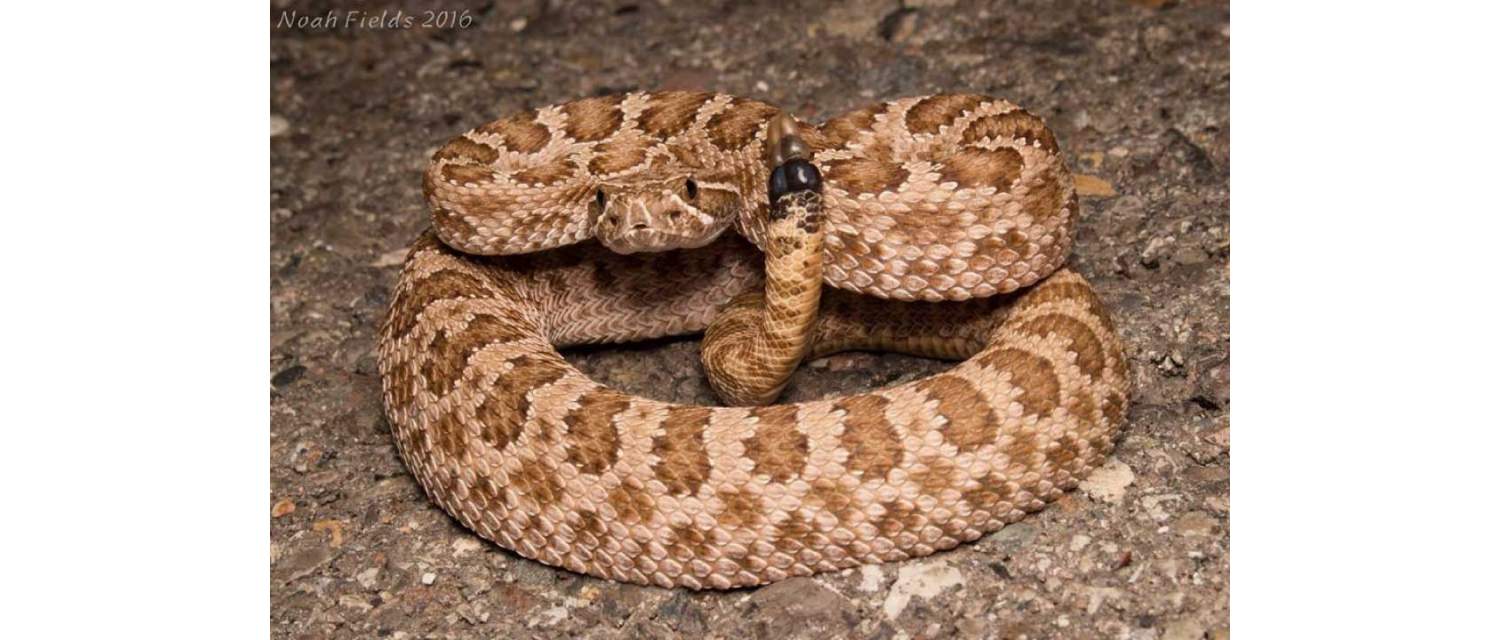
Crotalus viridis
(Rafinesque, 1818)
Nombre común:
Reino:
Phylum:
Clase:
Orden:
Suborden:
Familia:
Género:
Especie:
Subespecies:
Descripción:
La coloración dorsal varía mucho entre poblaciones y también conforme crece el organismo; en los adultos el cuerpo es color verde oliva, gris, gris oscuro o negro. La parte superior de la cabeza usualmente no presenta marcas, en el costado se ve una línea tenue y delgada que corre desde la parte superior del ojo hasta el cuello. También tiene una línea oscura detrás de los ojos. El patrón de manchas dorsales va de 27 a 43 marcas obscuras mas o menos hexagonales delineadas por una hilera sencilla de escamas claras; las manchas se vuelven más delgadas y más parecidas a bandas hacia la parte posterior. En los costados del cuerpo se distingue una serie de manchas obscuras medianas en forma de diamante. Por lo general el vientre es opaco frecuentemente punteado. La coloración de los juveniles es más obscura teniendo casi siempre fondo negruzco y las marcas en forma de diamante más claras; las marcas de la cabeza son muy evidentes especialmente la banda supraocular (sobre) y postorbital (detrás) de los ojos. Algunas veces el fin de la cola y el botón del cascabel son amarillos.
Tamaño:
Hábitos:
Alimentación:
Reproducción:
Número de crías:
Distribución geográfica:
Distribución en México:
- Chihuahua
- Coahuila
- Sonora
Hábitat:
Estatus de protección:
IUCN:
Literatura citada:
1. Aird, S. D., C. S. Seebart & I. I. Kaiser. 1988. Preliminary fractionation and characterization of the venom of the Great Basin Rattlesnake (Crotalus viridis lutosus). Herpetologica, 44(1): 71-85.
2. Aldridge, R. D. 1979. Seasonal spermatogenesis in sympatric Crotalus viridis and Arizona elegans in New Mexico. J. Herpetol., 13(2): 187-192.
3. Aldridge, R. D. 1993. Male Reproductive Anatomy and seasonal occurrence of mating and combat behavior of the Rattlesnake Crotalus v. viridis. J. Herpetol., 27(4): 481-484.
4. Aldridge, R.D. 2002. The Link between mating season and male reproductive anatomy in the Rattlesnakes Crotalus viridis oreganus and Crotalus viridis helleri. J. Herpetol., 36(2): 295-300.
5. Ashton, K.G. 1999. Shedding aggregations of Crotalus viridis concolor. Herpetol. Rev., 30(4): 211-213.
6. Ashton, K.G. 2001. Body size variatoin among mainland populations of the Western Rattlesnake (Crotalus viridis). Evolution, 55: 2523-2533.
7. Ashton, K. G.; de Queiroz, A. 2001. Molecular systematics of the Western Rattlesnake, Crotalus viridis (Viperidae), with comments on the utility of the D-Loop in phylogenetic studies of snakes. Molecular Phylogenetics and Evolution 21(2):176-189.
8. Campbell, J. A. and W. W. Lamar 2004. The Venomous Reptiles of the Western Hemisphere, 2 vols. Comstock (Cornell University Press), Ithaca, NY, 962 pp.
9. Chiszar, D., L. J. Livo, R. R. J. Smith & H. M. Smith. 1995. Geographic Distribution. Crotalus viridis. Herpetol. Rev., 26(3): 156.
10. Conant, R. & Collins, J. T. 1991. A Field Guide to Reptiles and Amphibians of Eastern/Central North America, 3rd ed. Houghton Mifflin (Boston/New York), xx + 450 p.
11. Diller, L.V. & R.L. Wallace. 2002. Growth, reproduction, and survival in a population of Crotalus viridis oreganus in North Central Idaho. Herpetol. Monogr., 16: 26-45.
12. Frost, D. R., Hammerson, G. A. & Santos-Barrera, G. 2007. Crotalus viridis. In: IUCN 2008. 2008 IUCN Red List of Threatened Species. . Downloaded on 22 December 2008.
13. Graves, B. M. & D. Duvall. 1993. Reproduction, rookery use, and thermoregulation in free-ranging, pregnant Crotalus v. viridis. J. Herpetol., 27(1): 33-41.
14. Greene, H. W. 1997. Snakes. The Evolution of Mistery in Nature. University of California Press. 351 pp.
15. Grismer, L. L. 2002. Amphibians and reptiles of Baja California including its pacific Islands and the Islands in the Sea of Cortés. University of California Press. 399 pp.
16. Hayes, W.K. 1986. Observations of courtship in the rattlesnake, Crotalus viridis oreganus. J. Herpetol., 20(2): 246-249.
17. Klauber, L. M. 1938. Notes from a herpetological diary, I Copeia 1938 (4): 191-197.
18. Klauber, L. M. 1972. Rattlesnakes: Their habits, life histories and influence on mankind. Berkeley: University of California Press.
19. Lemos Espinal, J. A. 2003. Crotalus viridis. Fichas diagnósticas para 10 especies de anfibios y reptiles mexicanos. Facultad de Estudios Superiores Iztacala, Universidad Nacional Autónoma de México. Bases de datos SNIB-CONABIO. Proyecto W002. México. D.F.
20. McDiarmid, R. W.; Campbell, J. A. & Touré, T. A. 1999. Snake species of the world. Vol. 1. Herpetologists’ League, 511 pp.
21. NatureServe. 2005. NatureServe Explorer: An online encyclopedia of life [web application]. Version 4.6. NatureServe, Arlington, Virginia. Available http://www.natureserve.org/explorer.
22. Platt, S. G. et al. 2006. A herpetofaunal survey of southwestern South Dakota with an emphasis on species of conservation concern. Journal of Kansas Herpetology 20: 10-19.
23. Rafinesque, C.S. 1818. Further accounts of discoveries in natural history in the western states. American Month. Mag. Crit. Rev. 4 (1): 41.
24. Stebbins,R.C. 1985. A Field Guide to Western Reptiles and Amphibians, 2nd ed. Houghton Mifflin, Boston.
25. Wallace, R.L. & L.V. Diller. 1990. Feeding ecology of the Rattlesnake, Crotalus viridis oreganus, in Northern Idaho. J. Herpetol., 24(3): 246-253. 26. Winchell, S. 2007. Klapperschlangen! Die Gattung Crotalus. Reptilia (Münster) 12 (4): 18-25.

